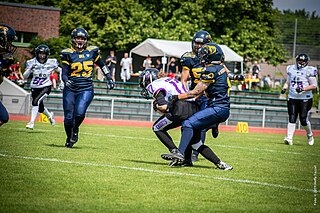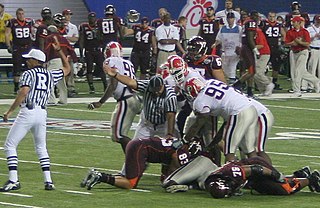A play from scrimmage is the sequence in the game of gridiron football during which one team tries to advance the ball, get a first down, or score, and the other team tries to stop them or take the ball away. Once a play is over, and before the next play starts, the football is considered dead. A game of American football consists of many such plays.

Super Bowl IX was an American football game played between the American Football Conference (AFC) champion Pittsburgh Steelers and the National Football Conference (NFC) champion Minnesota Vikings to decide the National Football League (NFL) champion for the 1974 season. The game was played on January 12, 1975, at Tulane Stadium in New Orleans, Louisiana. The Steelers defeated the Vikings by the score of 16–6 to win their first Super Bowl championship.

Super Bowl XII was an American football game between the National Football Conference (NFC) champion Dallas Cowboys and the American Football Conference (AFC) champion Denver Broncos to decide the National Football League (NFL) champion for the 1977 season. The Cowboys defeated the Broncos 27–10 to win their second Super Bowl. The game was played on January 15, 1978, at the Louisiana Superdome in New Orleans. This was the first Super Bowl in a domed stadium, and the first time that the game was played in prime time in the Eastern United States.

A fumble in gridiron football occurs when a player who has possession and control of the ball loses it before being downed (tackled), scoring, or going out of bounds. By rule, it is any act other than passing, kicking, punting, or successful handing that results in loss of ball possession by a player.

A touchdown is a scoring play in gridiron football. Whether running, passing, returning a kickoff or punt, or recovering a turnover, a team scores a touchdown by advancing the football into the opponent's end zone. More specifically, a touchdown is when a player is in possession of the ball, any part of the ball is in the end zone they are attacking, and the player is not down.

Gridiron football, also known as North American football, or in North America as simply football, is a family of football team sports primarily played in the United States and Canada. American football, which uses 11 players, is the form played in the United States and the best known form of gridiron football worldwide, while Canadian football, which uses 12 players, predominates in Canada. Other derivative varieties include arena football, flag football and amateur games such as touch and street football. Football is played at professional, collegiate, high school, semi-professional, and amateur levels.

A down is a period in which a play transpires in gridiron football. The down is a distinguishing characteristic of the game compared to other codes of football but is synonymous with the 6 "tackle" rule in rugby league. The team in possession of the football has a limited number of downs to advance ten yards or more towards their opponent's goal line. If they fail to advance that far, possession of the ball is turned over to the other team. In most situations if a team reaches their final down, they will punt to their opponent, which forces their opponent to begin their drive from further down the field; if they are in range, they might instead attempt to score a field goal.
In American football, a touchback is a ruling that is made and signaled by an official when the ball becomes dead on or behind a team's own goal line and the opposing team gave the ball the momentum, or impetus, to travel over or across the goal line but did not have possession of the ball when it became dead. Since the 2018 season, touchbacks have also been awarded in college football on kickoffs that end in a fair catch by the receiving team between its own 25-yard line and goal line. In the 2023 season, the NFL adopted the same rules as college football in regards to awarding touchbacks on kickoffs that end in a fair catch. In 2024, the NFL moved the placement of the ball after a touchback on a kickoff to the receiving team's 30-yard line; this was part of a radical change to the league's kickoff procedure. Such impetus may be imparted by a kick, pass, fumble, or in certain instances by batting the ball. A touchback is not a play, but a result of events that may occur during a play. A touchback is the opposite of a safety with regard to impetus since a safety is scored when the ball becomes dead in a team's end zone after that team — the team whose end zone it is — caused the ball to cross the goal line.

American and Canadian football are gridiron codes of football that are very similar; both have their origins partly in rugby football, but some key differences exist between the two codes.

Gameplay in American football consists of a series of downs, individual plays of short duration, outside of which the ball is or is not in play. These can be plays from scrimmage – passes, runs, punts or field goal attempts – or free kicks such as kickoffs and fair catch kicks. Substitutions can be made between downs, which allows for a great deal of specialization as coaches choose the players best suited for each particular situation. During a play, each team should have no more than 11 players on the field, and each of them has specific tasks assigned for that specific play.

The National Football League playoffs for the 1988 season began on December 24, 1988. The postseason tournament concluded with the San Francisco 49ers defeating the Cincinnati Bengals in Super Bowl XXIII, 20–16, on January 22, 1989, at Joe Robbie Stadium in Miami, Florida.
An incomplete pass is a term in gridiron football which means that a legal forward pass is not successfully caught by an eligible offensive player within the field of play. An incomplete pass can occur if (1) the ball hits the ground in the field of play before a player on either team gains possession; (2) the ball is caught by a player on either team who, at the moment of possession is out of bounds; or (3) the ball is thrown outside the field of play. An incomplete pass causes the down to advance by one and the offensive team gains no yards. The game clock is stopped.

In American football and Canadian football, a quarterback kneel, also called taking a knee, genuflect offense, kneel-down offense, or victory formation, occurs when the quarterback touches a knee to the ground immediately after receiving the snap, thus downing himself and ending the play. It is primarily used to run the clock down, either at the end of the first half or the game itself, to preserve a lead or ensure a game goes into overtime if the game is tied and in the fourth quarter. Although it generally results in a loss of some yardage and uses up a down, it minimizes the risk of a fumble, which would give the other team a chance at recovering the ball.

A comparison of American football and rugby union is possible because of the games' shared origins, despite their dissimilarities.
The following terms are used in American football, both conventional and indoor. Some of these terms are also in use in Canadian football; for a list of terms unique to that code, see Glossary of Canadian football.
In gridiron football, a turnover on downs occurs when a team's offense has used all their downs but has not progressed downfield enough to earn another set of downs. The resulting turnover gives possession of the ball to the team on defense.

In gridiron football, a penalty is a sanction assessed against a team for a violation of the rules, called a foul. Officials initially signal penalties by tossing a bright yellow colored penalty flag onto the field toward or at the spot of a foul.

In gridiron football, a punt is a kick performed by dropping the ball from the hands and then kicking the ball before it hits the ground. The most common use of this tactic is to punt the ball downfield to the opposing team, usually on the final down, with the hope of giving the receiving team a field position that is more advantageous to the kicking team when possession changes. The result of a typical punt, barring any penalties or extraordinary circumstances, is a first down for the receiving team. A punt is not to be confused with a drop kick, a kick after the ball hits the ground, now rare in both American and Canadian football.

In sports, possession is physical control of the ball or other implement of play by one team, which typically gives that team the opportunity to score. Sports have different rules governing how possession is kept or lost, which affect the strategy of gameplay. The number of possessions or total time of possession are often useful statistics of team or individual performance.














